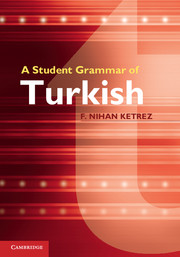Book contents
- Frontmatter
- Contents
- Acknowledgments
- Conventions used in the book
- Chapter 1 Introduction
- Chapter 2 The sounds of Turkish
- Chapter 3 The noun: an overview
- Chapter 4 Case markers
- Chapter 5 Genitive and possessive
- Chapter 6 Numerals and plurality
- Chapter 7 Existential var / yok
- Chapter 8 Pronouns
- Chapter 9 The verb: an overview
- Chapter 10 -Iyor, the progressive
- Chapter 11 Future with -(y)AcAK
- Chapter 12 Past with -DI and -(y)DI
- Chapter 13 -mIş and -(y)mIş
- Chapter 14 Present tense with the aorist -Ir/-Ar
- Chapter 15 -mAktA and -DIr
- Chapter 16 Imperative and optative
- Chapter 17 Compound tenses
- Chapter 18 Person markers
- Chapter 19 Postpositions
- Chapter 20 Passive
- Chapter 21 Causative
- Chapter 22 Reflexive
- Chapter 23 Reciprocal
- Chapter 24 Subordination
- Chapter 25 Infinitives with -mA and -mAK
- Chapter 26 Adjectives
- Chapter 27 Adverbials
- Chapter 28 Conditional
- Chapter 29 Ability and possibility with -(y)Abil
- Chapter 30 Obligation and necessity
- Chapter 31 Relative clauses
- Chapter 32 Word order
- Chapter 33 Questions
- Chapter 34 Negation
- Chapter 35 Coordination
- Chapter 36 Diminutive
- Chapter 37 Reduplication
- Chapter 38 Interjections and some idiomatic expressions
- Chapter 39 Spelling and punctuation
- Chapter 40 Conversation
- Appendix A Verbal inflection paradigms
- Appendix B Nominal inflection paradigms
- Appendix C Verbs categorized according to their case-marked complements
- Appendix D Verbs categorized according to their clausal complement types
- Appendix E Selected grammar books for further study
- Appendix F Answer key to the exercises
- Appendix G Glossary of grammatical terms
- Index
Chapter 14 - Present tense with the aorist -Ir/-Ar
Published online by Cambridge University Press: 05 June 2012
- Frontmatter
- Contents
- Acknowledgments
- Conventions used in the book
- Chapter 1 Introduction
- Chapter 2 The sounds of Turkish
- Chapter 3 The noun: an overview
- Chapter 4 Case markers
- Chapter 5 Genitive and possessive
- Chapter 6 Numerals and plurality
- Chapter 7 Existential var / yok
- Chapter 8 Pronouns
- Chapter 9 The verb: an overview
- Chapter 10 -Iyor, the progressive
- Chapter 11 Future with -(y)AcAK
- Chapter 12 Past with -DI and -(y)DI
- Chapter 13 -mIş and -(y)mIş
- Chapter 14 Present tense with the aorist -Ir/-Ar
- Chapter 15 -mAktA and -DIr
- Chapter 16 Imperative and optative
- Chapter 17 Compound tenses
- Chapter 18 Person markers
- Chapter 19 Postpositions
- Chapter 20 Passive
- Chapter 21 Causative
- Chapter 22 Reflexive
- Chapter 23 Reciprocal
- Chapter 24 Subordination
- Chapter 25 Infinitives with -mA and -mAK
- Chapter 26 Adjectives
- Chapter 27 Adverbials
- Chapter 28 Conditional
- Chapter 29 Ability and possibility with -(y)Abil
- Chapter 30 Obligation and necessity
- Chapter 31 Relative clauses
- Chapter 32 Word order
- Chapter 33 Questions
- Chapter 34 Negation
- Chapter 35 Coordination
- Chapter 36 Diminutive
- Chapter 37 Reduplication
- Chapter 38 Interjections and some idiomatic expressions
- Chapter 39 Spelling and punctuation
- Chapter 40 Conversation
- Appendix A Verbal inflection paradigms
- Appendix B Nominal inflection paradigms
- Appendix C Verbs categorized according to their case-marked complements
- Appendix D Verbs categorized according to their clausal complement types
- Appendix E Selected grammar books for further study
- Appendix F Answer key to the exercises
- Appendix G Glossary of grammatical terms
- Index
Summary
The meaning and use
The aorist -Ir/-Ar is used to express general facts, polite requests and questions, probable situations, uncertain plans, guesses, habits, likes and dislikes. Here are some examples for each category.
General facts
Güneş doğudan doğar. ‘Sun rises from the east.’
Balık suda yaşar. ‘Fish lives in water.’
İki kere iki dört eder. ‘Two times two is four.’
Penguenler uçmaz. ‘Penguins do not fly.’
Polite requests and questions
Lütfen kapıyı açar mısınız? ‘Could you open the door?’
Lütfen tuzu verir misiniz? ‘Could you pass the salt?’
Benimle evlenir misin? ‘Will you marry me?’
Probable situations, uncertain plans
Yarın belki sinemaya gideriz. ‘Maybe we go to the movies tomorrow.’
Belki Selim de bizimle gelir. ‘Maybe Selim comes with us.’
Guesses
Sence bu sene dünya kupasını kim alır? ‘In your opinion, who gets the world cup this year?’
Annem bu elbiseyi beğenmez. ‘My mother wouldn't like this dress.’
Habits, likes, dislikes
Ben kahveyi şekerli içerim. ‘I drink coffee with sugar.’
Ben asla kahve içmem. ‘I never drink coffee.’
Ne tür filmlerden hoşlanırsınız? ‘What kind of movies do you like?’
Ne tür müzik seversiniz? ‘What kind of music do you like?’
The form
In contrast to the other tense markers, the aorist has a semi-irregular pattern, that is, there is a set of verbs that irregularly take -Ir rather than -Ar and you will need to memorize them. Here are the details of the aorist pattern.
Polysyllabic words ending in consonants take one of the variants of -Ir, which can appear as -ır, -ir, -ur, -ür due to I-type vowel harmony, e.g., pişir-ir, götür-ür, konuş-ur, çalış-ır.
Most monosyllabic verbs ending in consonants take one of the variants of -Ar. -Ar can appear as -er or -ar due to A-type vowel harmony, e.g., yap-ar, ser-er, koş-ar, ör-er, kır-ar, gir-er, sus-ar, gül-er.
Vowel-ending verbs take only -r, e.g., eri-r, söyle-r, uyu-r, atla-r.
Here is the irregular part. These thirteen verbs, although they are monosyllabic, take -Ir rather than -Ar. Most of them are l- or r- ending. Only the verb san- is n-ending: al-ır, bil-ir, bul-ur, dur-ur, gel-ir, gör-ür, kal-ır, ol-ur, öl-ür, san-ır, ver-ir, var-ır, vur-ur
- Type
- Chapter
- Information
- A Student Grammar of Turkish , pp. 108 - 112Publisher: Cambridge University PressPrint publication year: 2012



